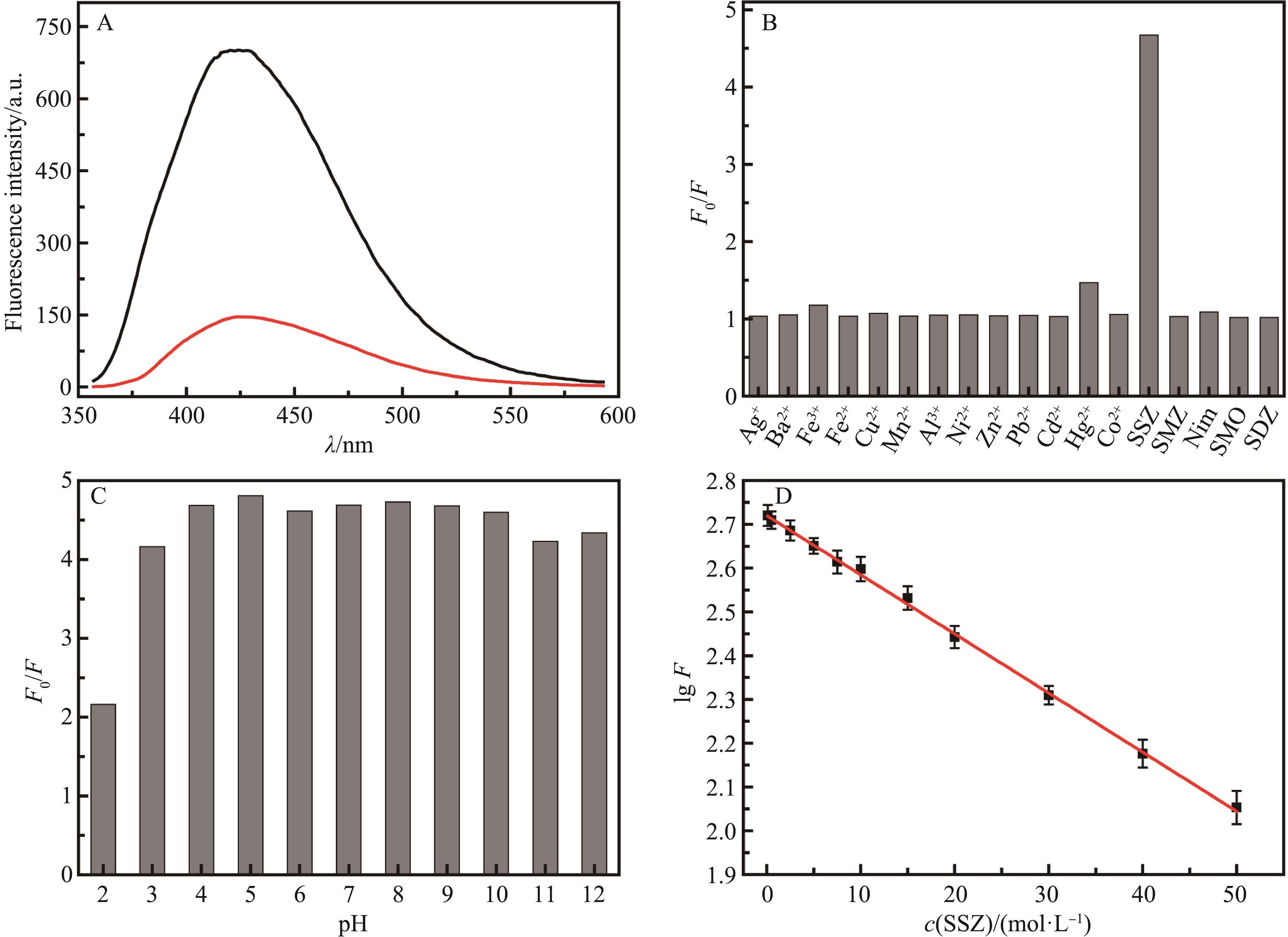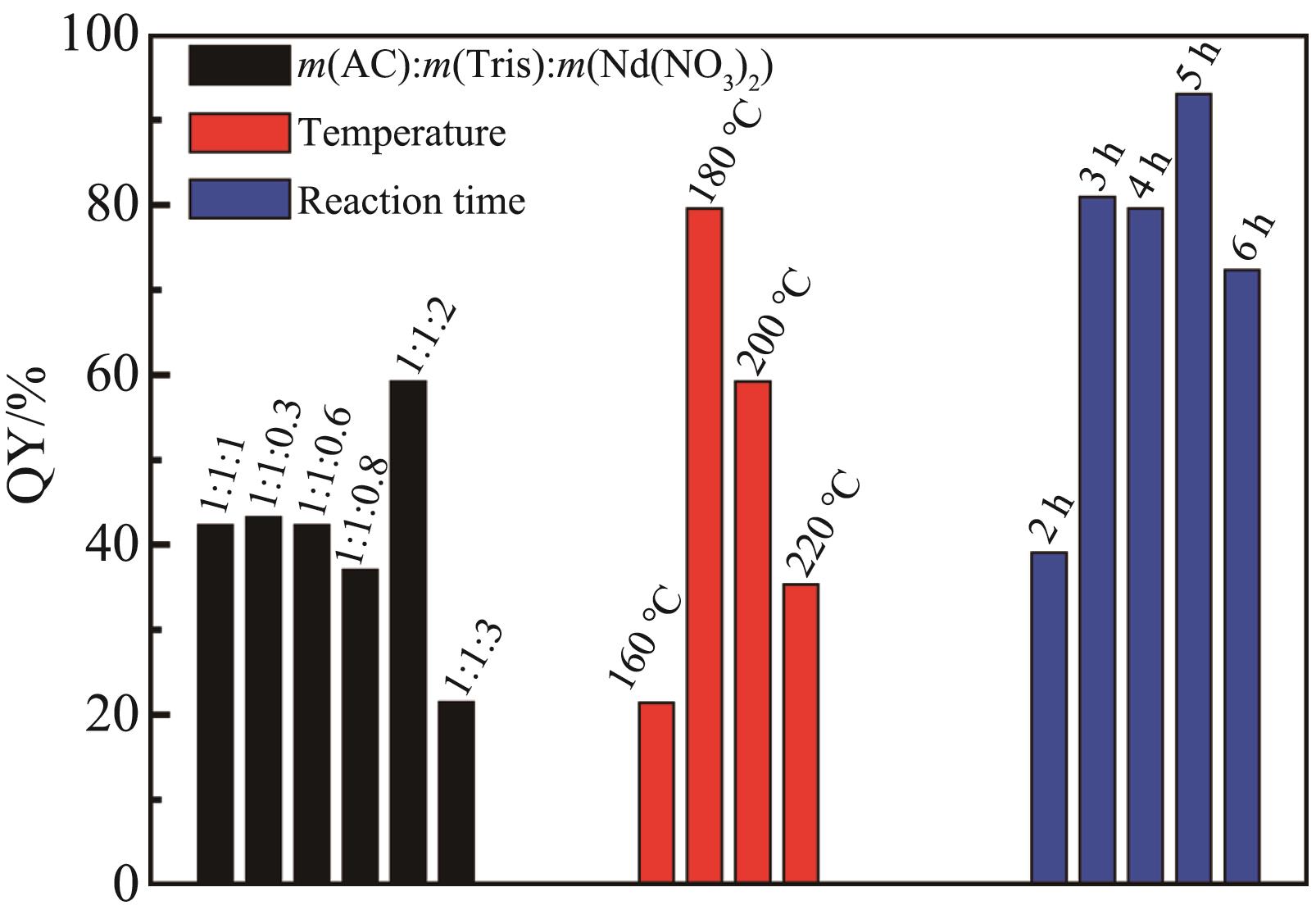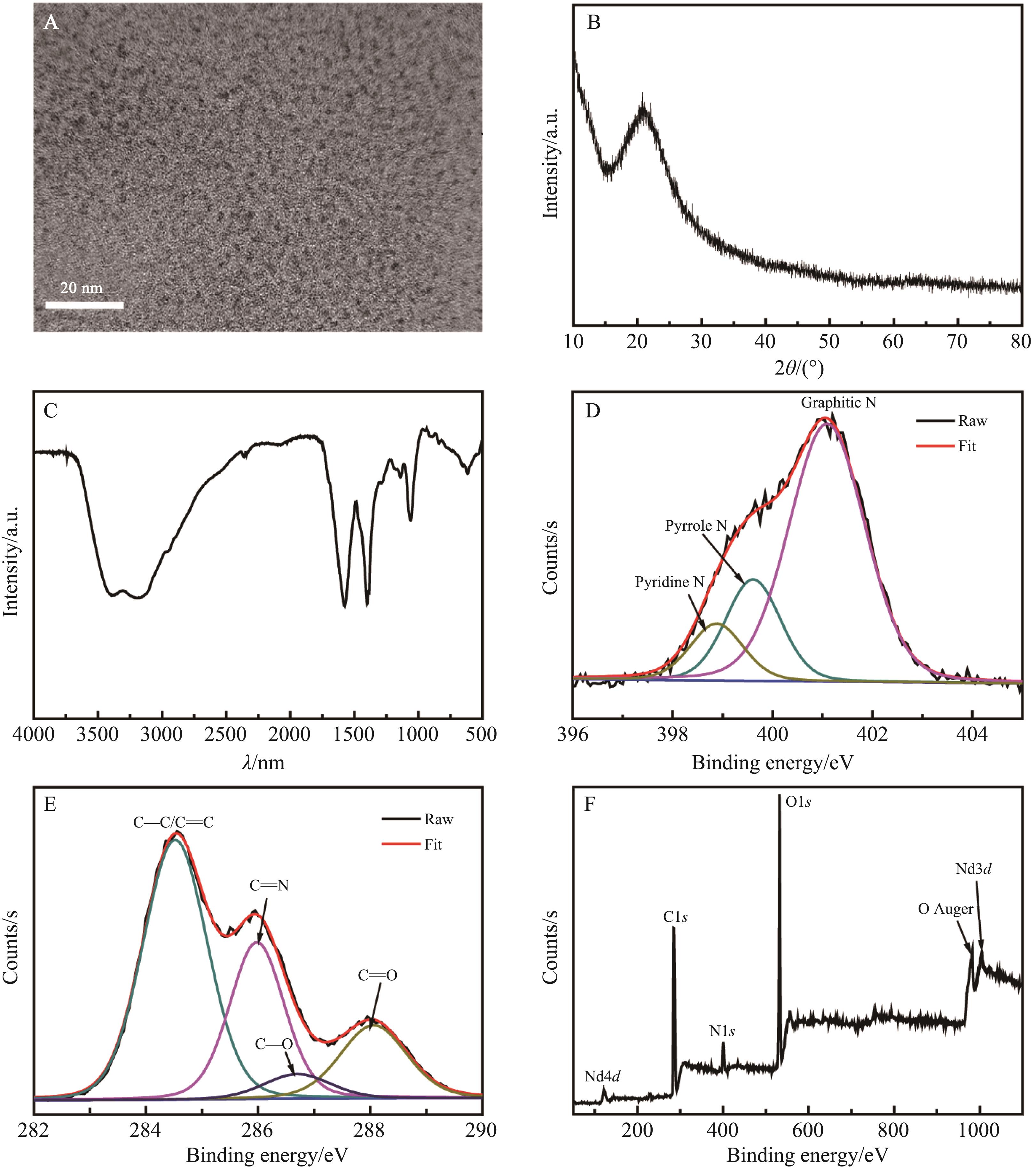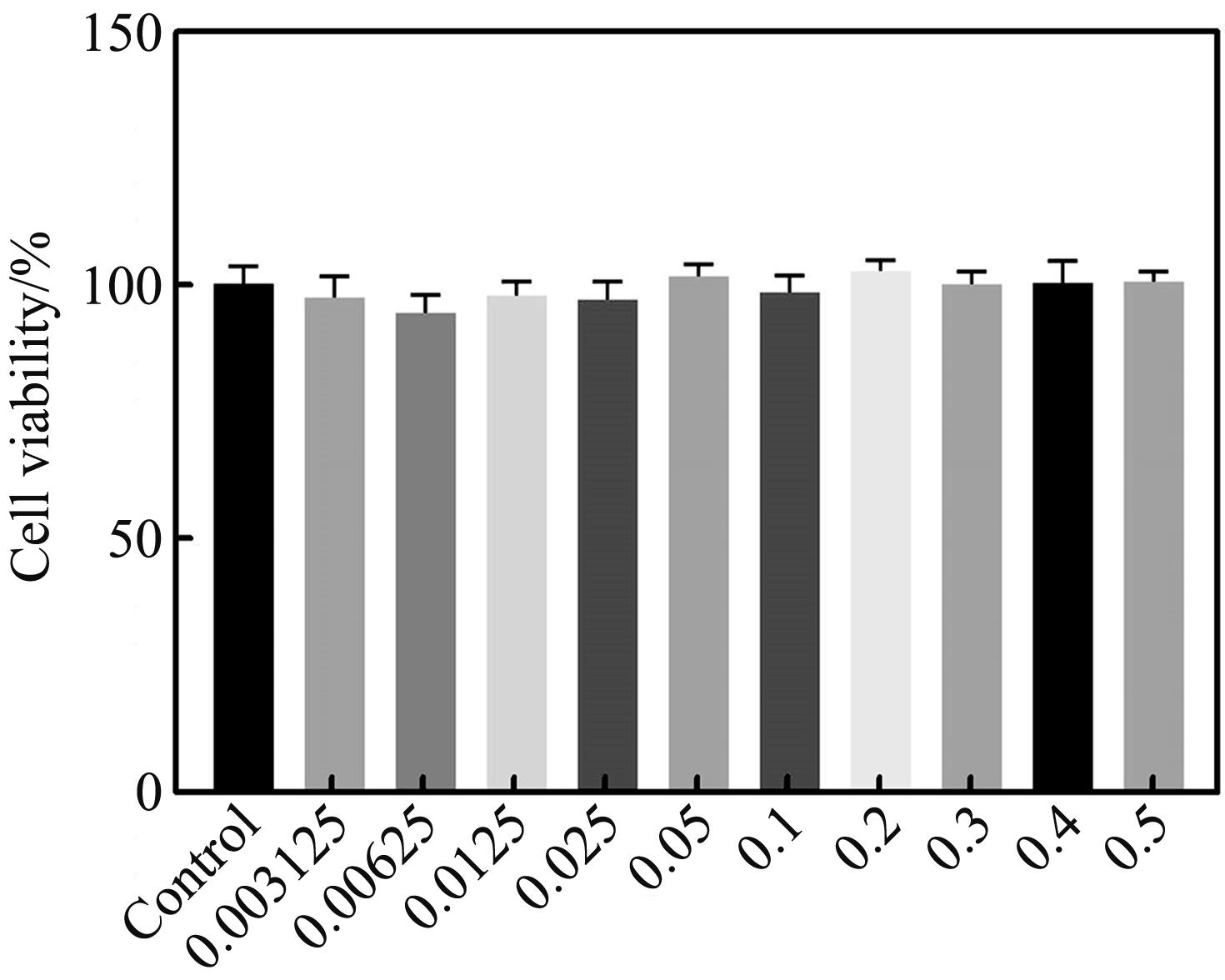
Chinese Journal of Applied Chemistry ›› 2022, Vol. 39 ›› Issue (11): 1726-1734.DOI: 10.19894/j.issn.1000-0518.220041
• Full Papers • Previous Articles Next Articles
Neodymium and Nitrogen Co‑doped Carbon Dots with High Fluorescence Quantum Yield for Detection of Sulfasalazine and Hela Cell Imaging
Jin-Ping SONG1, Qi MA1( ), Xiao-Min LIANG2, Jian-Peng SHANG1, Chuan DONG(
), Xiao-Min LIANG2, Jian-Peng SHANG1, Chuan DONG( )
)
- 1.College of Chemistry and Chemical Engineering,Institute of Applied Chemistry,Shanxi Datong University,Datong 037009,China
2.School of Chemistry and Material Science,Shanxi Normal University,Linfen 041004,China
3.Institute for Environmental Science,Shanxi University,Taiyuan 030006,China
-
Received:2022-02-21Accepted:2022-04-20Published:2022-11-01Online:2022-11-09 -
Contact:Qi MA,Chuan DONG -
About author:dc@sxu.edu.cn
maqihx@163.com;
-
Supported by:the Natural Science Foundation of Shanxi Province(201901D111309);the Research Project Foundation of Datong City(2019027)
CLC Number:
Cite this article
Jin-Ping SONG, Qi MA, Xiao-Min LIANG, Jian-Peng SHANG, Chuan DONG. Neodymium and Nitrogen Co‑doped Carbon Dots with High Fluorescence Quantum Yield for Detection of Sulfasalazine and Hela Cell Imaging[J]. Chinese Journal of Applied Chemistry, 2022, 39(11): 1726-1734.
share this article
Add to citation manager EndNote|Ris|BibTeX
URL: http://yyhx.ciac.jl.cn/EN/10.19894/j.issn.1000-0518.220041

Fig.3 (A) UV-Vis and fluorescence spectra of Nd,N-CDs; (B) Fluorescence spectra under different excitation wavelength; (C) Influence of pH on fluorescence intensity; (D) Influence of ionic strength on fluorescence intensity

Fig.4 (A) Fluorescence spectra before and after adding SSZ; (B) Selective response histogram; (C) Influence of pH on the detection of SSZ; (D) Linear curve of the detection of SSZB: The concentration of metal ions and drug molecular is 50 μmol/L, respectively
检测方法 Detection method | 传感体系 Sensor system | 线性范围 Linear range/(μmol·L-1) | 检出限 Detection limit/(μmol·L-1) | 参考文献 Ref. |
|---|---|---|---|---|
色谱法 Chromatography | — | 62.75 ~ 753 | — | [ |
| — | 0.5 ~ 7.5/7.5 ~125.5 | 0.5 | [ | |
比色法 Colorimetric method | Android smartphone | 25 ~ 125 | 8.28 | [ |
电化学法 Electrochemical method | NiO/CNT/IL/CPE | 0.5 ~ 800 | 0.09 | [ |
| MWCNTCOOH/BA?SPCE | 1.0 ~ 14, 14 ~70 | 0.3 | [ | |
| BiNP?CNT/GCE | 0.05 ~ 10 | 0.13 | [ | |
荧光法 Fluorescence method | N?CDs | 0.85 ~ 17 | 0.08 | [ |
| Tb?DPA complex | 0.08 ~ 6, 1 ~100 | 0.06 | [ | |
| CdS nanoparticle | 1.26 ~ 250 | 0.25 | [ | |
| Nd,N?CDs | 0.1 ~ 50 | 0.05 | 本文 This work |
Table 1 Comparison of analytical methods for detection of SSZ
检测方法 Detection method | 传感体系 Sensor system | 线性范围 Linear range/(μmol·L-1) | 检出限 Detection limit/(μmol·L-1) | 参考文献 Ref. |
|---|---|---|---|---|
色谱法 Chromatography | — | 62.75 ~ 753 | — | [ |
| — | 0.5 ~ 7.5/7.5 ~125.5 | 0.5 | [ | |
比色法 Colorimetric method | Android smartphone | 25 ~ 125 | 8.28 | [ |
电化学法 Electrochemical method | NiO/CNT/IL/CPE | 0.5 ~ 800 | 0.09 | [ |
| MWCNTCOOH/BA?SPCE | 1.0 ~ 14, 14 ~70 | 0.3 | [ | |
| BiNP?CNT/GCE | 0.05 ~ 10 | 0.13 | [ | |
荧光法 Fluorescence method | N?CDs | 0.85 ~ 17 | 0.08 | [ |
| Tb?DPA complex | 0.08 ~ 6, 1 ~100 | 0.06 | [ | |
| CdS nanoparticle | 1.26 ~ 250 | 0.25 | [ | |
| Nd,N?CDs | 0.1 ~ 50 | 0.05 | 本文 This work |
温度 Temperature/K | 猝灭常数 Quenching constant/(L·mol-1) | 双分子反应速率常数 Bimolecular reaction rate constant/(L·mol-1·s-1) | 相关系数 Correlation coefficient |
|---|---|---|---|
| 298 | 5.15×104 | 3.98×1012 | 0.990 4 |
| 310 | 5.37×104 | 4.15×1012 | 0.997 4 |
| 318 | 5.67×104 | 4.39×1012 | 0.999 4 |
Table 2 Stern?Volmer quenching constant and bimolecular reaction rate constant at different temperatures
温度 Temperature/K | 猝灭常数 Quenching constant/(L·mol-1) | 双分子反应速率常数 Bimolecular reaction rate constant/(L·mol-1·s-1) | 相关系数 Correlation coefficient |
|---|---|---|---|
| 298 | 5.15×104 | 3.98×1012 | 0.990 4 |
| 310 | 5.37×104 | 4.15×1012 | 0.997 4 |
| 318 | 5.67×104 | 4.39×1012 | 0.999 4 |
样品 Sample | 测定值 Found/(μmol·L-1) | 加标量 Spiked/(μmol·L-1) | 总测定值 Total found/(μmol·L-1) | 回收率 Recovery/% | 相对标准偏差 RSD/% |
|---|---|---|---|---|---|
| 1 | 8.18 | 0 | 8.18 | — | 3.2 |
| 2 | 8.18 | 5.00 | 13.14 | 99.2 | 4.4 |
| 3 | 8.18 | 10.00 | 17.99 | 98.1 | 7.0 |
| 4 | 8.18 | 15.00 | 23.81 | 104.2 | 2.7 |
| 5 | 8.18 | 25.00 | 32.82 | 98.6 | 0.6 |
Table 3 Content analysis and recovery results of SSZ in tablets (n =3)
样品 Sample | 测定值 Found/(μmol·L-1) | 加标量 Spiked/(μmol·L-1) | 总测定值 Total found/(μmol·L-1) | 回收率 Recovery/% | 相对标准偏差 RSD/% |
|---|---|---|---|---|---|
| 1 | 8.18 | 0 | 8.18 | — | 3.2 |
| 2 | 8.18 | 5.00 | 13.14 | 99.2 | 4.4 |
| 3 | 8.18 | 10.00 | 17.99 | 98.1 | 7.0 |
| 4 | 8.18 | 15.00 | 23.81 | 104.2 | 2.7 |
| 5 | 8.18 | 25.00 | 32.82 | 98.6 | 0.6 |

Fig.6 Confocal fluorescence images of Hela cells after incubating in Nd,N-CDs solution (Left is fluorescence field image under 405 nm excitation wavelength, middle is bright field image, and right is overlay image)
| 1 | KWIECIEŃ A, PIATEK K, ŻMUDZKI P, et al. TLC-Densitometric determination of sulfasalazine and its possible impurities in pharmaceutical preparations[J]. Acta Chromatogr, 2015, 27(4): 623-635. |
| 2 | 孙宁云, 常靓. 柳氮磺吡啶肠溶片耐酸力和溶出度检测方法的建立与研究[J]. 中国现代药物应用, 2015, 9(17): 273-276. |
| SUN N Y, CHANG L. Establishment and research of detection methods for acid tolerance and dissolution rate in sulfasalazine enteric-coated tablet[J]. Chinese J Mod Drug Appl, 2015, 9(17): 273-276. | |
| 3 | BEITOLLAHI H, YOONESFAR R. Sensitive detection of sulfasalazine at a carbon paste electrode modified with NiO/CNT nanocomposite and ionic liquid in pharmaceutical and biological samples[J]. Inorg Nano-Met Chem, 2017, 47(10): 1441-1448. |
| 4 | SOPHIA A E, LAILA I, AZIZ A. Smartphone-based colorimetric determination of sulfadiazine and sulfasalazine in pharmaceutical and veterinary formulations[J]. Instrum Sci Technol, 2018, 46(6): 656-675. |
| 5 | SADEGHI S, OLIAEI S. Optimization of ionic liquid based dispersive liquid-liquid microextraction combined with dispersive micro-solid phase extraction for the spectrofluorimetric determination of sulfasalazine in aqueous samples by response surface methodology[J]. RSC Adv, 2016, 6: 113551-113560. |
| 6 | ALI H, GHOSH S, JANA N R. Fluorescent carbon dots as intracellular imaging probes[J]. WIREs Nanomed Nanobiotechnol, 2020, 12(4): e1617(1-15). |
| 7 | WANG H Y, LU Q J, HOU Y X, et al. High fluorescence S, N co-doped carbon dots as an ultra-sensitive fluorescent probe for the determination of uric acid[J]. Talanta, 2016, 155: 62-69. |
| 8 | SONG J P. LIANG X M, MA Q, et al. Fluorescent boron and nitrogen co-doped carbon dots with high quantum yield for the detection of nimesulide and fluorescence staining[J]. Spectrochim Acta A, 2019, 216: 296-302. |
| 9 | ZHU P P, CHENG Z, DU L L, et al. Synthesis of the Cu-doped dual-emission fluorescent carbon dots and its analytical application[J]. Langmuir, 2018, 34: 9982-9989. |
| 10 | XU Q, SU R, CHEN Y, et al. Metal charge transfer doped carbon dots with reversibly switchable, ultra-high quantum yield photoluminescence[J]. ACS Appl Nano Mater, 2018, 1: 1886-1893. |
| 11 | PAKKATH S A R, CHETTY S S, SELVARASU P, et al. Transition metal ion (Mn2+, Fe2+, Co2+, and Ni2+)-doped carbon dots synthesized via microwave-assisted pyrolysis: a potential nanoprobe for modality-fluorescent dual-modality bioimaging[J]. ACS Biomater Sci Eng, 2018, 4: 2582-2596. |
| 12 | LIU S, CUI J, HUANG J, et al. Facile one-pot synthesis of highly fluorescent nitrogen-doped carbon dots by mild hydrothermal method and their applications in detection of Cr(VI) ions[J]. Spectrochim Acta A, 2019, 206: 65-71. |
| 13 | SHANGGUAN J, HUANG J, HE D, et al. Highly Fe3+-selective fluorescent nanoprobe based on ultrabright N/P codoped carbon dots and its application in biological samples[J]. Anal Chem, 2017, 89: 7477-7484. |
| 14 | ZHAO L, WANG Z, HAN D, et al. Preparation of carbon nanotube-neodymium oxide composite and research on its catalytic performance[J]. Mater Res Bull, 2009, 44(5): 984-988. |
| 15 | WU F, SU H, ZHU X. Near-infrared emissive lanthanide hybridized carbon quantum dots for bioimaging applications[J]. J Mater Chem B, 2016, 4(38): 6366-6372. |
| 16 | ABDELRAHMAN M M, HABIB N M, EMAM A A, et al. Chromatographic determination of sulfasalazine and its active metabolites: greenness assessment and application to spiked human plasma[J]. Biomed Chromatogr, 2020, 34(4): e4804(1-12). |
| 17 | SADEGHI S, GARMROODI A. Sensitive detection of sulfasalazine at screen printed carbon electrode modified with functionalized multiwalled carbon nanotubes[J]. J Electroanal Chem, 2014, 727: 171-178. |
| 18 | NIGOVIĆ B, JURIĆ S, MITROVIĆ I, Bismuth nanoparticles-carbon nanotubes modified sensor for sulfasalazine analysis[J]. Talanta, 2017, 164: 201-208. |
| 19 | ZHANG Z, CHEN J, DUAN Y, et al. Highly luminescent nitrogen-doped carbon dots for simultaneous determination of chlortetracycline and sulfasalazine[J]. Luminescence, 2018, 33(2): 318-325. |
| 20 | YAN J, YU Y, KONG B, et al. Highly sensitive detection of sulfasalazine based on the fluorescence quenching of a terbium complex probe[J]. Microchem J, 2020, 154: 104553. |
| 21 | 张犁黎, 郑行望, 屈颖娟, 等. 硫化镉纳米粒子荧光猝灭测定柳氮磺吡啶[J]. 陕西师范大学学报(自然科学板), 2006, 34(2): 74-76, 79. |
| ZHANG L L, ZHENG X W, QU Y J, et al. A method for determination of sulfasalazine based on fluorescence quenching of CdS nanoparticles[J]. J Shaanxi Normal Univ (Nat Sci Ed), 2006, 34(2): 74-76, 79. |
| [1] | Yue-Xia ZHANG, Xiao-Peng FAN, Yu-Juan CAO, Xin-Tong YANG, Zhong-Ping LI, Zhen-Hua YANG, Chuan DONG. Synthesis of Oil-soluble Carbon Quantum Dots by Pyrolysis Method for the Detection of Oxytetracycline [J]. Chinese Journal of Applied Chemistry, 2023, 40(4): 509-517. |
| [2] | Rui-Zhe WANG, Guang-Qi HU, Wei-Hao YE, Chao-Fan HU, Jian-Le ZHUANG, Bing-Fu LEI, Wei LI, Ying-Liang LIU. Hydrothermal Preparation and Application of Oil-soluble Carbon Dots with High Ultraviolet-short-wave Blue Light Shielding [J]. Chinese Journal of Applied Chemistry, 2023, 40(1): 59-68. |
| [3] | Zhen-Hua YANG, Xuan-Sen SUN, Yue-Xia ZHANG, Yu-Juan CAO, Qi-Qi ZHANG, Qiao-Zhi GUO, Xiao-Peng FAN, Zhong-Ping LI, Chuan DONG. Preparation of Nitrogen Sulfur Co⁃doped Carbon Dots with Nitrogen Sulfur and the Application for Detection of Oxytetracycline in Milk [J]. Chinese Journal of Applied Chemistry, 2022, 39(9): 1382-1390. |
| [4] | Lian-Bo TANG, Da-You FU, Qi CHEN, Yang-Run FENG, Ya-Lin XIONG, Zhu-Qing WANG. Enhanced Gas⁃Liquid Chemiluminescence by Carbon Dots for Determination of Carbon Dioxide [J]. Chinese Journal of Applied Chemistry, 2022, 39(8): 1294-1302. |
| [5] | Hai-Yan QI, Chen-Qi ZHANG, Jin-Long LI, Jun LI. Synthesis of Sulfur and Nitrogen Doped Carbon Dots for Cu(Ⅱ) Detection [J]. Chinese Journal of Applied Chemistry, 2022, 39(6): 980-989. |
| [6] | Dan MENG, Kai-Yuan ZHENG, Shan-Shan CHEN, Zhao-Long ZHUO, Li-Li WANG. Preparation and Luminescence Properties of Silicon and Nitrogen Co⁃doped Carbon Dots Phosphors [J]. Chinese Journal of Applied Chemistry, 2022, 39(11): 1766-1773. |
| [7] | LIU Qiao-Ling, REN Bo-Rong, LIU Rui-Rong, LI Yu-Xia, WANG Gui-Xiang, REN Zi-Wei, DONG Chuan. N-Doped Carbon Dots with Ratio Fluorescent Detection for Ag+ [J]. Chinese Journal of Applied Chemistry, 2021, 38(11): 1512-1520. |
| [8] | HU Guowen, QIAO Yuling. Folic Acid-Carbon Dot Conjugates for Cancer Cell Targeting [J]. Chinese Journal of Applied Chemistry, 2020, 37(9): 1003-1009. |
| [9] | HU Guowen, QIAO Yuling. Folic Acid-Carbon Dot Conjugates for Cancer Cell Targeting [J]. Chinese Journal of Applied Chemistry, 2020, 37(9): 0-0. |
| [10] | XU Liping, LIU Qingshi, DONG Zhichen, GUO Xingjia, DONG Wei. Simple, Fast and Accurate Detection of Ciprofloxacin Based on Fluorescence Enhancement of Nitrogen-Doped Carbon Dots [J]. Chinese Journal of Applied Chemistry, 2020, 37(7): 830-838. |
| [11] | MENG Yating, JIAO Yuan, ZHANG Yuan, GAO Yifang, LU Wenjing, LIU Yang, DONG Chuan. Synthesis of Red Emission Fluorescent Carbon Dots and Its Application for Detection of Persulfate [J]. Chinese Journal of Applied Chemistry, 2020, 37(6): 719-725. |
| [12] | GONG Hui, KANG Yu, ZHANG Rong, REN Guodong, HOU Xiaoyu, ZHANG Min, LI Lihong, LIU Wen, WANG Haojiang, DIAO Haipeng. Preparation of Nitrogen-Doped Carbon Dots for Highly Sensitive Detection of Amoxicillin [J]. Chinese Journal of Applied Chemistry, 2020, 37(2): 227-234. |
| [13] | GAO Man, HE Xin, CUI Jingnan, LIU Tao, TIAN Zhenhao, HE Shengui. A Coumarin-Based Fluorescent Probe for Rapid Detection of Endogenous Formaldehyde [J]. Chinese Journal of Applied Chemistry, 2019, 36(9): 1053-1060. |
| [14] | HUANG Xiaomei,DENG Xiang. Preparation of New Photoluminescent Carbon Dots and Its Application in Hg2+ Detection [J]. Chinese Journal of Applied Chemistry, 2019, 36(5): 603-610. |
| [15] | BU Lulu,WANG Qing,XIE Yongshu. Research Progress of Fluorescent Zinc Probes [J]. Chinese Journal of Applied Chemistry, 2017, 34(12): 1355-1369. |
| Viewed | ||||||
|
Full text |
|
|||||
|
Abstract |
|
|||||


